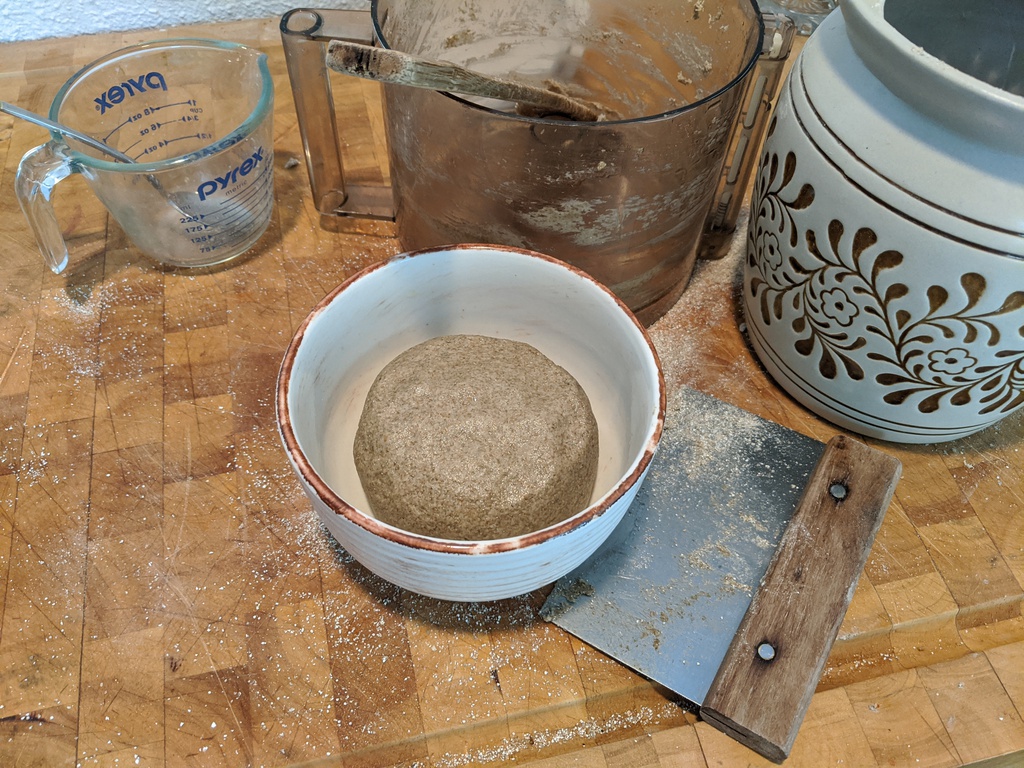I found some kind of grain growing alongside a new bike path in the area. Following some basic identification methods, it appears to be rye as best I can tell. (Cautionary note: one friend had an allergic reaction, aka itchy face and throat after eating some bread that he made using flour ground from this grain, so). I'm love to know how this grain ended up getting planted here. Was wheat intentionally grown on the hillsides for a reason? Or did they mean to grow regular grass and accidentally grabbed a sack of wheat seeds instead? One theory is that they rented a seed spreader which happened to contain a bit of grain from the previous rental.
After a few successful experiments with harvesting small amounts of the grain and milling the grain into flour, I had to try my hand at harvesting enough to make something substantial like a loaf of bread or pizza dough from scratch scratch. I recruited the help of my nieces M and S to harvest the rye wheat heads:

A few days before finding this grain growing I had watched this video which did a nice job of preparing me to make flour at home. As luck would have it, the guy even used the same food processor I have to thresh the wheat! Here are photos threshing and winnowing the wheat, then weighing the resulting grains:
Next the grains were milled in the Vitamix blender, sifted, then weighed again. In just a few hours we have two-and-half pounds of whole grain flour!
Some of my previous experiments include eating the raw berries, making freekeh, making a tiny pizza, making a somewhat failed (by failed I just mean flat and dense) loaf of bread, and using the flour like corn meal for preventing sticking while making regular pizza. All the experiments were amazingly delicious with tons of nutty whole-grain flavor, they were just a little dense. Using the whole grain flour like corn meal was amazing, it imparted a strong and delicious "whole grain" flavor to the pizza without getting in the way of the rest of the process of kneading and rising the dough.

Making a little whole-grain pizza 
The finished whole-grain test pizza 
The flat loaf of bread
Finally I think I'm ready to try my hand at pizza dough. The whole grain flour is challenging to work with because it doesn't behave like all-purpose flour. Specifically it doesn't want to form into a cohesive mass, instead it becomes more of a peanut-butter-like paste. Most recipes call for using something like 75% all-purpose flour and only 25% whole grain flour to avoid these problems, but I'm determined to avoid mixing in any supermarket flour and use 100% whole grain flour, to see what happens. I tried the best I could to knead the dough, but it defied kneading by hand. It was too sticky. I put it in the food processor and added a little oil which seemed to do an ok job of kneading the dough, although it still didn't develop into a gluteny stretchy dough. I formed it into a ball, put it into an oiled bowl, covered it with a wet towel, and stored it in a warm place for a few hours to rise.
The dough rose nicely, doubling in size. With a little care, it stretched nicely into a pizza, although it lacked elasticity. It was more like working with play-dough than a stretchy dough made from white flour.
The pizza came out good, except it lacked the light, air-bubbly quality of dough made from all-purpose flour. Also it was definitely doughy, which as I understand is a quality typical of bread made from rye. I have read that for this reason, it's typical to let rye bread sit for a day after making it, but I'm not sure that would translate well to pizza-making.
I have a little more of the flour left. I think the next pizza will be made with 75% white flour and 25% whole grain flour. I'm curious to see how that turns out.

Questions:
- How can I make all-purpose flour from wheat? (I think a fine sieve might be able to sift out the all-purpose flour)
- When all-purpose flour is made, what do they do with the remaining bran, etc.? (Wheaties are made, for one.)














